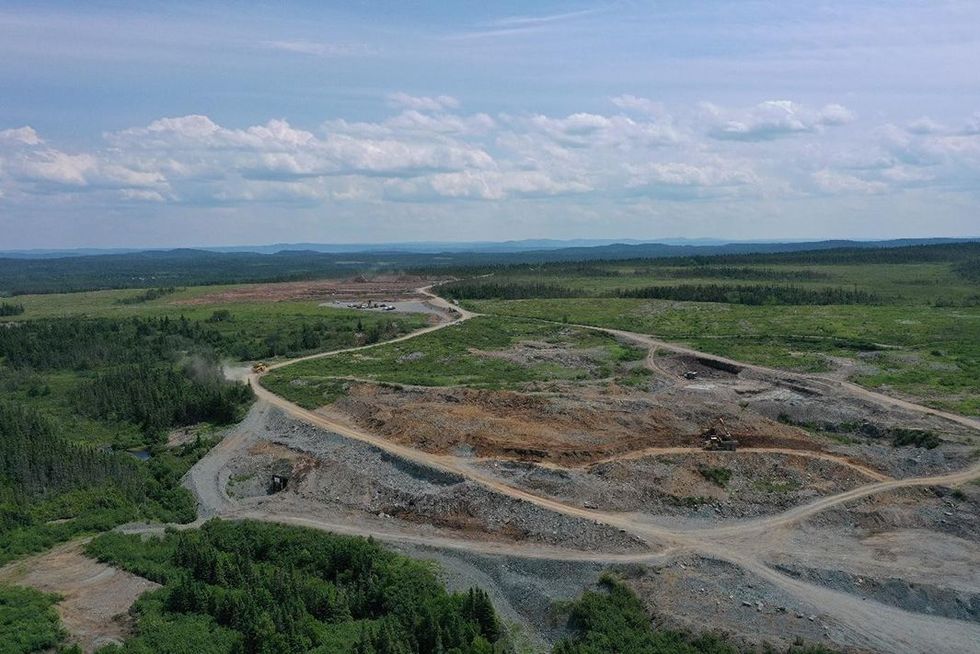CAT Strategic Metals Corporation (CSE:CAT)(OTC PINK:CATTF)(FRA:8CH) ("CAT" or the 'Company') announces the following update on its Rimrock Gold-Silver mineral property in Midas and Hollister Mines area of Elko County, Nevada
RIMROCK Gold-Silver Property
The Rimrock Property is situated 15 Km southeast of Hecla Mining's high-grade Midas gold-silver mine, and 3 km north of its Hollister gold-silver mine. Hecla's new high-grade Green Racer gold-silver discovery lies 13 km NW of Rimrock.
Drone Aeromagnetic Survey Completed. A first-ever drone aeromagnetic survey was conducted by Zonge Geophysics of Reno, Nevada for CAT Strategic Metals. Zonge used a Drone platform to do the new survey, using 50-metre space flight lines, and coordinated using GPS servers. These data augmented ground magnetics conducted by Kent Exploration in 2004. The data package is being interpreted for CAT by Bolin Geophysical Surveys LLC. CAT has scheduled a dipole-dipole induced polarization survey by Zonge to be conducted in the next quarter to better define exploration targets at depth at Rimrock.
Mapping Uncovers 3 New Gold-Silver Drilling Targets. New geologic mapping and rock-chip sampling was conducted by CAT's geologist at Rimrock. This led to the discovery of 3 new gold-silver drilling targets, in addition to the "Silver Hill" and Rhombochasm" targets. CAT now has 5 exciting drilling targets to pursue in coming months.
1. Dilation (Western Mineralized) Zone is a large, old, 3 Km long NNE-trending, locally mineralized fault system that occurs in the northern part of the Rimrock property. Midas-Hollister-style low-sulfidation gold-silver targets are present along the zone. Structurally-controlled mercury-bearing mineralization is present in and near the IC Fault, which is believed to also be a pre-Carlin age structure that was reactivated and host to different events of mineralization. A large fault jog is present; here termed the "Rhombochasm" zone. This is over 200 meters wide and 1 km long, forming a major structural target for gold-silver mineralization. The northern area had been previously mapped in detail, the emphasis during this mapping program was to extend the zone to the southwest.
Silicification was found to extend another 400 meters to the southwest from the end of the previous mapping becoming gradually weaker and replaced by QSP mineralization and eventually aerially extensive argillic alteration. Reconnaissance mapping further southwest determined little true exposures exist in the area of interest. However, drilling in 2007 did identify elevated gold mineralization (to 187 ppb) hosted by volcanic tuff, exists within this zone. Multi-elemental analyses indicate the gold interval is also elevated with respect to sulfur, selenium, arsenic, antimony, tungsten and molybdenum. To a lesser degree barium and rhenium are elevated. These results are indicative of Midas Style precious metals mineralization is extant in this area.
Holes drilled further to the west in this area also intersected Paleozoic sedimentary rocks (quartzites and mudstones) below the volcanics. The uppermost interval, immediately below the volcanic section, of this formation is composed of quartzite. It is elevated in silver and gold (to 29.5 ppm and 85 ppb respectively) which is associated with elevated tellurium, selenium, antimony and vanadium; and to a lesser consistency molybdenum, chromium, copper and arsenic. The Dilation Zone is large enough to host a good-size, high-grade gold-silver deposit for the Company.
2. Eastern Zone is 100 to 250 metres wide in a north-south oriented area of chalcedonic alteration, is accompanied by quartz-sericite-pyrite (oxidized) and argillic alteration of mostly volcanic tuff and tuffaceous lithologies. The widest portions of significant alteration are found at the south end in the vicinity of Silver Hill, an area underlain by high grade silver mineralization (to 262 ppm) intersected in the 2007 drill program, and again to the north where it eventually intersects and alters a large area of the basal units of the 14.92 Ma Rhyolite Porphyry. In terms of exposed area, the Eastern Alteration Zone is significantly larger than the Western or Dilation Alteration Zone. The overall length of the exposed, discontinuous silicic mineralization is 1.5 km; it continues at least another 750 meters into the Rhyolite Porphyry where it is expressed principally as QSP alteration.
Alteration is typically a silica core surrounded by less silicified areas enriched in iron (now oxidized) mineralization and associated sericite (QSP alteration). This, in turn, is surrounded by argillic alteration. Silicification is discontinuous and defined by three distinct areas, from south to north, Silver Hill, Central and Northern Zones; each is roughly 200 to 300 meters in overall length.
Chalcedonic alteration is often associated with mercury mineralization (cinnabar, calomel, schuetteite and possibly others). Many areas show signs of prospecting. One area showed grey chalcedony containing meta-cinnabar forming a thin coating over rich cinnabar immediately below the exposed surface. Structures associated with the chalcedonic alteration are most frequently oriented at 020o (TN) and dip steeply west. Brecciation is often associated with cross-cutting structures which are occasionally accompanied by iron mineralization that has been demonstrated, through previous surface sampling, to contain elevated iron, mercury, arsenic and barium (± tungsten, molybdenum, nickel, bismuth, vanadium, selenium and lead); silver is also weakly elevated. This area has never been tested by drilling and looks quite prospective.
3. Shaft Zone Mineralization. The "Shaft Zone" has a 19 metre deep shaft developed in mercury-mineralized silicification and is host to a widespread area of mixed silicification, QSP and argillic alteration. It starts roughly 600 meters east of the "eastern Mineralized Zone" and continues at least 670 meters to the southeast of the shaft. Mineralization here is discontinues and mostly covered by cobble and boulder colluvium derived from the Rhyolite Porphyry. Silicification is principally chalcedonic replacement of tuff units, often associated with a halo of QSP and argillic alteration. Mineralization with the chalcedony replacement is principally goethite with lesser hematite, and meta-cinnabar and cinnabar at the collar of the shaft. The primary structural trend in this region is 020o which hosts the majority of the silicification and associated brecciation. Alteration within the lower units of the Rhyolite Porphyry is pronounced above and east of the shaft.
Conclusions. Five prospective target areas of mineralization are present in the Rimrock claims area. There may be gold-silver systems of 3 different ages present, and none have been tested properly by previous drilling to evaluate them. Strong alteration is present in several areas, often along with chalcedonic and mercury mineralization at the surface. This indicates that the gold targets lie at depth below the ground surface, and thus likely are underground mine targets. The Western and Eastern zones have drill data from the 2007 drilling program. This program identified Paleozoic rocks beneath the volcanic pile and are mineralized, to varying degrees with precious metals, which appear to have been mineralized both by Midas-Hollister age fluids, as well as locally by Carlin-type mineralizing fluids of Eocene age, as at Silver Hill. The Rimrock project area appears to be highly prospective for the discovery of gold-silver deposits that could be attractive to 3rd-party companies for acquisition.
Mr. Richard R. Redfern, M.S., C.P.G. No. 10717, is the qualified person as defined by National Instrument 43-101 who has examined the property on the ground, and who reviewed the geological information available from public sources related to the property, and is responsible for approving the technical contents of this press release.
Flow-Through Financing Final Closing
The Company also reports that it has closed the second, and final, tranche of the non-brokered flow-through private placement announced March 31, 2021 (the "Private Placement") of 586,112 flow-through units of the Company (the "FT Units"), at a price of CDN$0.09 per FT Unit, for gross proceeds of CDN$52,750.00. CAT will issue an aggregate total of 7,280,556 FT Units in connection with both the first and second tranche closings of the Private Placement, for total gross proceeds of CDN$655,250.00. The Company announced the first tranche closing of the Private Placement for gross proceeds of CDN$602,500.00, and the issuance of 6,694,444 FT Units on March 31, 2021.
Each FT Unit consists of one common share (a "FT Share") of the Company and one-half common share purchase warrant (the "FT Warrant"). Each whole FT Warrant, will entitle the holder to purchase one common share of the Company (the "FT Warrant Share") at a price of CDN$0.16 per FT Warrant Share until February 28, 2026.
The Company will pay finder's fees following the closing of the second and final tranche of the FT offering and submission of all necessary regulatory documentation as may be required. The finder's fees will include cash and finder's warrants, the details of which will be disclosed in a subsequent news release.
The proceeds from the issuance of the FT Units will be used for qualifying exploration on the Company's Canadian properties in New Brunswick and Saskatchewan and will entitle the holder to receive the applicable tax benefits in accordance with the provisions of the Income Tax Act (Canada). The Private Placement is subject to the receipt of all necessary regulatory approvals, including the approval of the Canadian Securities Exchange (the "CSE"). All securities issued pursuant to the Private Placement will be subject to a four month plus one day hold period in accordance with applicable Canadian securities laws.
About CAT Strategic Metals Corporation:
CAT Strategic Metals Corporation is a Canadian based mineral exploration company focused on the acquisition and de risking of overlooked projects situated in well-established World Class geological districts in North America. The Company is specially focused on minerals which are considered highly strategic from a monetary as well as global infrastructure and energy point of view. CAT's shares trade on the Canadian Securities Exchange (CSE) under the trading symbol "CAT", on the OTCMarkets.com under the trading symbol "CATTF", and on the Frankfurt Stock Exchange under the symbol "8CH".
ON BEHALF OF THE BOARD
Robert Rosner
Chairman, President & CEO
Further information regarding the Company can be found on SEDAR at www.SEDAR.com, by visiting the Company's website www.catstrategic.com or by contacting the Company directly at (604) 674-3145.
This news release may contain forward-looking statements. Forward-looking statements address future events and conditions and therefore involve inherent risks and uncertainties. Actual results may differ materially from those currently anticipated in such statements. Particular risks applicable to this press release include risks associated with planned production, including the ability of the company to achieve its targeted exploration outline due to regulatory, technical or economic factors. In addition, there are risks associated with estimates of resources, and there is no guarantee that a resource will be found or have demonstrated economic viability as necessary to be classified as a reserve. There is no guarantee that additional exploration work will result in significant increases to resource estimates
Neither Canadian Securities Exchange nor its Regulation Services Provider (as that term is defined in policies of the Canadian Securities Exchange) accepts responsibility for the adequacy or accuracy of this release.
We seek safe harbour
SOURCE: CAT Strategic Metals Corporation
View source version on accesswire.com:
https://www.accesswire.com/652794/CAT-Strategic-Metals-Completes-Mapping-and-Sampling-and-Drone-Mag-Survey-at-Rimrock-Gold-Silver-Property-Midas-Hollister-Camp-Elko-County-Nevada





 Hammerdown project site
Hammerdown project site